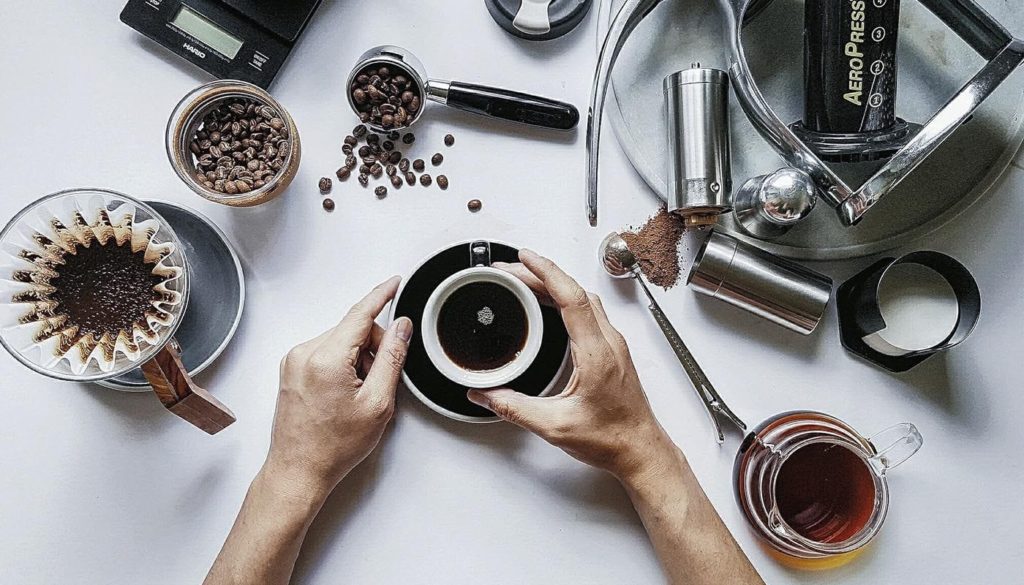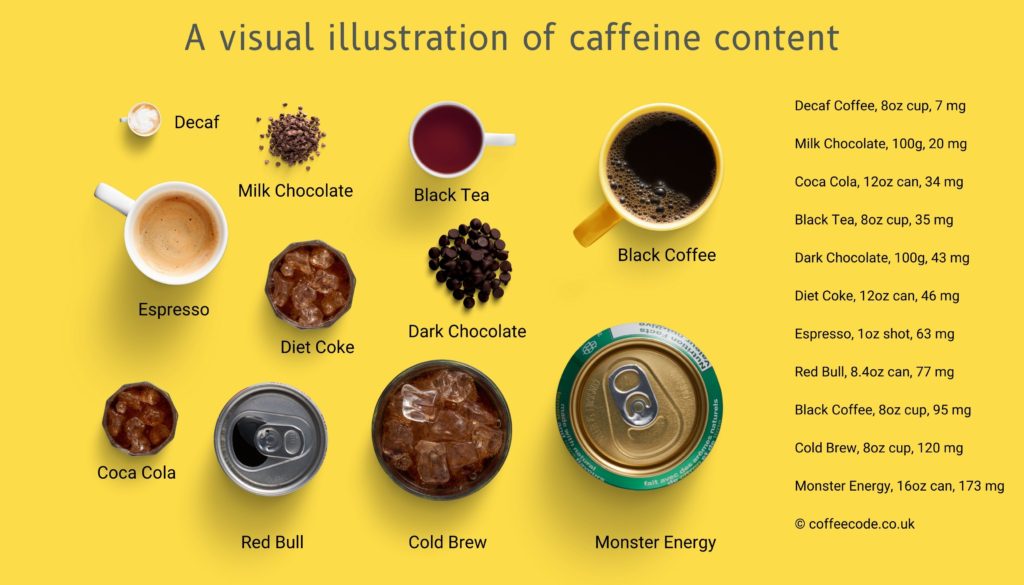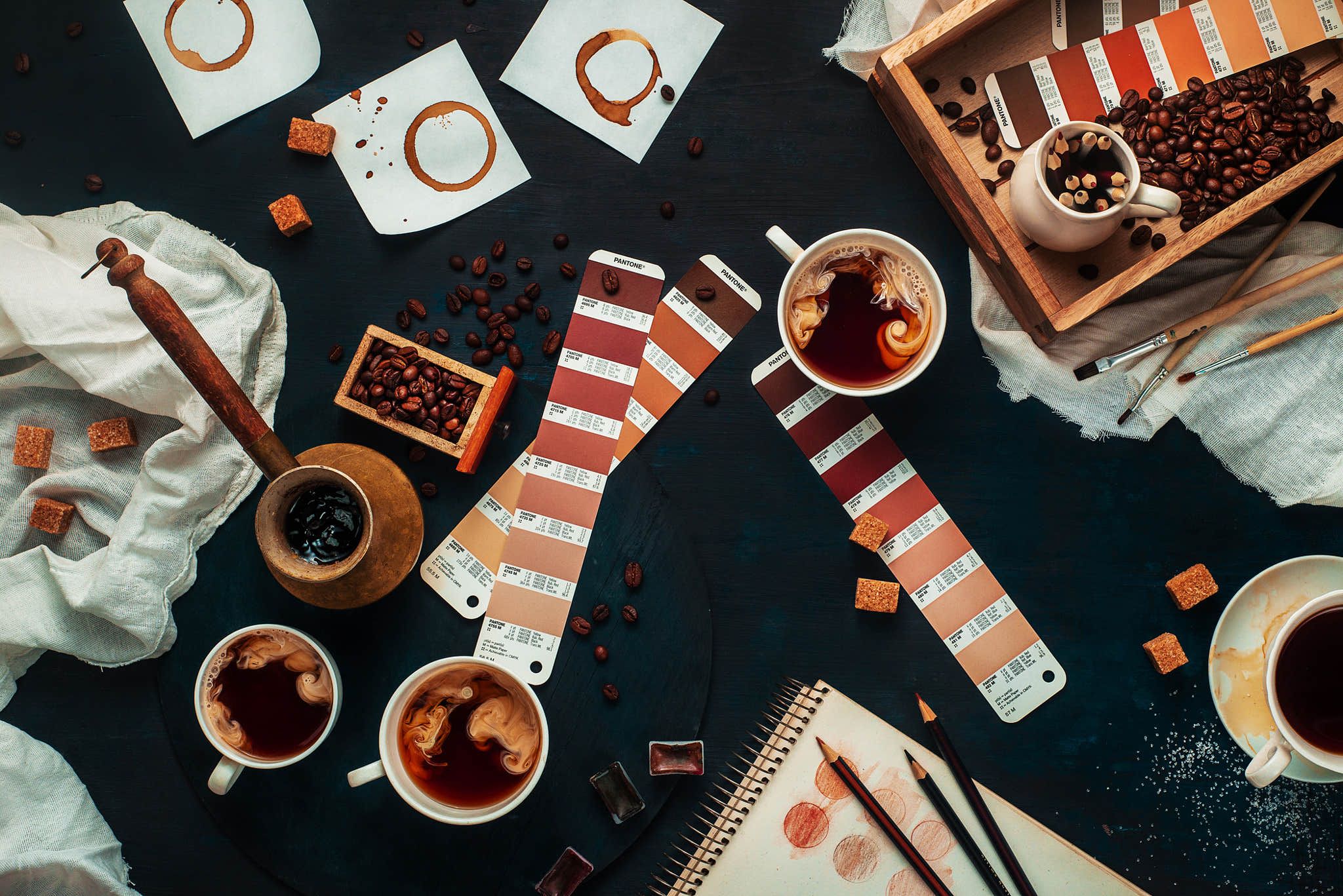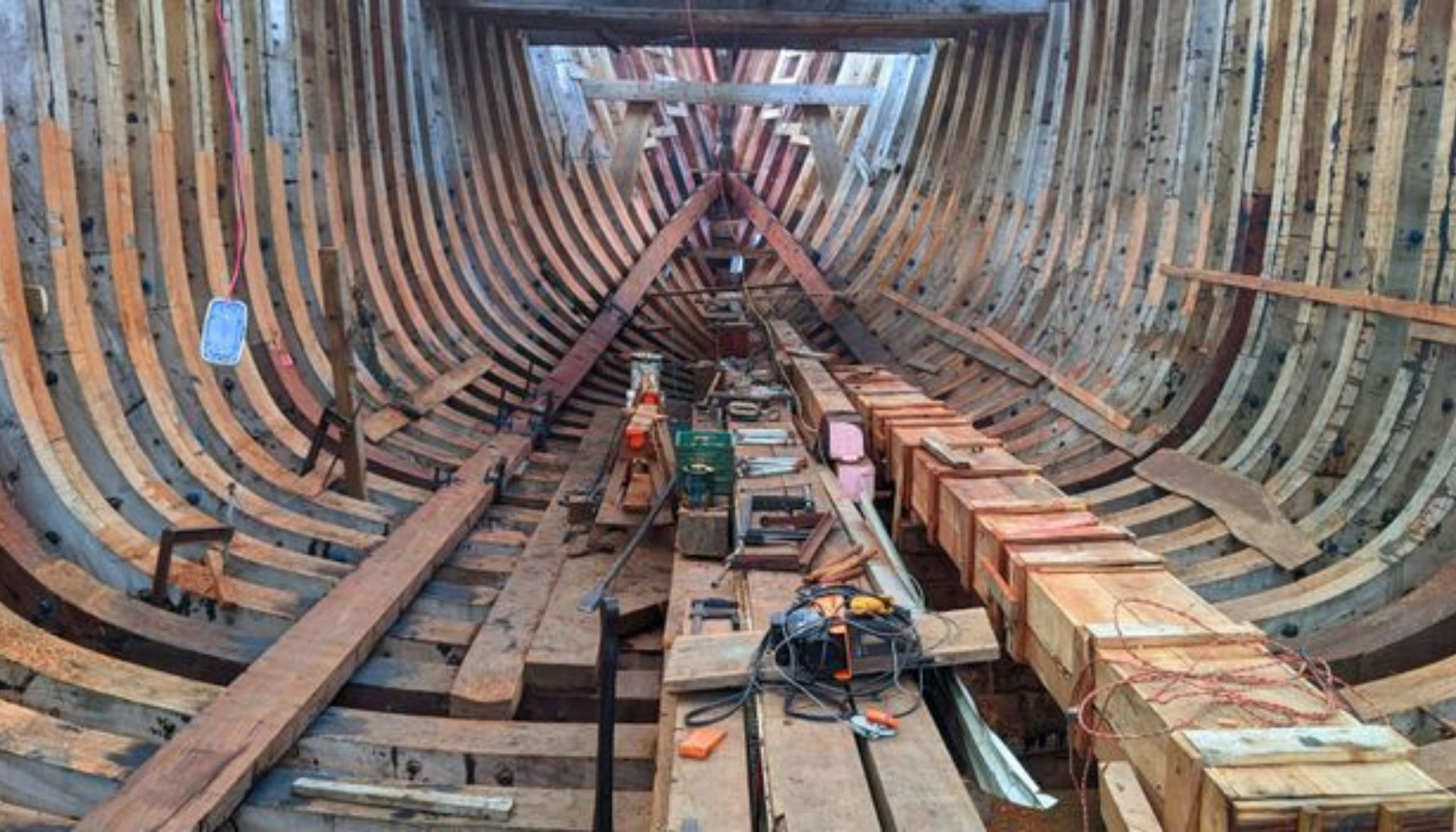How Much Caffeine is there in a Cup of Coffee?
Have you ever wondered how much caffeine there is in your coffee? There are a number of things that affect how much caffeine there is in a cup of coffee, including things like coffee type, brewing method and roast level – read on for the full explanation.
But as a guide, you can go with the following:
| Coffee Type | Approx. caffeine level | Serving size |
| Black coffee | 95mg | 8oz (235ml) cup |
| Espresso | 63mg | 1 shot (30ml) |
| Cappuccino | 63mg | 8oz (235ml) cup |
| Latte | 63mg | 8oz (235ml) cup |
| Flat White | 63mg | 5oz (140ml) cup |
| Cold brew | 120mg | 8oz (235ml) cup |
| Decaf coffee | 2-7mg | 8oz (235ml) cup |
That’s the short answer but read on to discover more about how much caffeine is in coffee and the different factors that affect the quantity/concentration.
What is Caffeine?

Caffeine is a natural stimulant that’s found in in the fruit, leaves or beans of coffee, tea, cacao and guarana plants, amongst other things. It’s a mild stimulant that boosts your alertness and energy levels, and is absorbed roughly 45 minutes after consuming. It peaks in your bloodstream anywhere between 15 minutes to 2 hours. In its raw form it’s a bitter white powder, and if you want the full technical term for it, it’s called 1,3,7 trimethylxanthine. Now that’s a mouthful.
Did you know that we consume over 100,000 tonnes of caffeine are year around the world? That’s the equivalent weight of 14 Eiffel Towers.
What Factors Affect how much caffeine there is in a cup of coffee?
There is no standard cup of coffee, or a standard method of brewing. Here are a few things that affect the caffeine content. We’ll delve into more detail down below.
- Coffee variety
- Brewing method
- Roast level
- Amount of coffee used
- Serving size
- Grind size
- Water temperature

1: Caffeine Content by Coffee Variety
There are more than 100 coffee species in use today, and by far the two most common types of coffee beans are Coffea arabica, commonly known as Arabica, and Coffea canephora, commonly known as Robusta.
These two coffees make up more than 99% of all the coffee consumed in the world today. Of that 99%, 75-80% is Arabica, and Robusta makes up around 20-25%. Article about forgotten beans.

According to this study, Robusta typically contains roughly twice as much caffeine as Arabica beans. The study found that Arabica beans contain 34-38g of caffeine per kilogram of dry coffee, whereas Robusta beans contain 68-81g of caffeine per kilogram of dry coffee. That’s a significant difference!
2: Caffeine Content of coffee by Brewing method

The way your coffee is brewed also makes a big difference to caffeine content. Because of all the variations it’s impossible to give the exact figures, but this study goes fairly in-depth. We’ve listed it by concentration to give a reasonable comparison of how brewing affects the caffeine content.
| Brewing Method | Caffeine mg/L |
| Espresso | 4200 |
| Moka Pot or Stovetop | 2192 |
| Cold Brew | 2240 |
| French Press or Plunger | 744 |
| Pour Over or Filter | 692 |
Oh, and while we’re talking about brewing methods and Moka Pots, check out this Moka Pot Size Guide article by Elijah Coffee – very handy!
3: Caffeine Content by Roast Level
This is an interesting one. Caffeine is very stable through the roasting process, but technically dark roast coffee is less dense, so it contains more caffeine by weight. It really doesn’t make that much difference. This article delves into the subject in more depth.

4: Caffeine Content by Amount of Coffee Used
This is a bit of an obvious one isn’t it? But it’s a factor, so we’ve included it. Put more coffee in, and you’ll get more caffeine. Just bear in mind that it won’t increase pro-rata, assuming all the other variables stay the same because there’s more coffee, so it won’t get the same extraction.

5: Serving size
Another obvious one we had to include! Coffee sizes vary between a Ristretto (25ml) to a Starbucks Venti which is a whopping 568ml. But bigger does not necessarily mean stronger, as all the other variables and recipes make a difference.

6: Grind size
Let’s make it clear: you should never adjust your coffee grind to get more or less caffeine. But it does make a difference and is normally dictated by the brew method you are using.
The coarser the grind, the less extraction there is and the less caffeine you will get. The finer the grind, the greater the surface area which means you’ll get more extraction and more caffeine.

7: Water temperature
The hotter the water, the more caffeine will be dissolved and extracted out the coffee. Again, this is only one variable and depends on brewing times.

How much caffeine can I drink per day? Recommended daily intake
Lots! Depending on which study you read, you’ll get loads of different amounts, usually skewed in the direction of the purpose of the study. All that said, it’s widely agreed that 400mg of caffeine per day is safe for most healthy adults. This works out between four and five cups a day, depending on which coffee you drink.

And seriously, you’re unlikely to fatally overdose, although it has happened before when an overdose led to complications.
The lethal dose of caffeine is roughly 150mg per kg of your body weight. So if you weigh 70kg you would need to consume 14,000mg of caffeine to overdose. This equates to around 70 large cups of strong coffee. You’d also need to consume it all at once, which is basically impossible.
There’s an interesting article by the British Heart Foundation which explores how much caffeine is too much.
What are the benefits of caffeine?

Apart from waking you up and making you more energetic, caffeine offers you these benefits:
1. It improves your mood and boosts your mental function
Caffeine increases dopamine production, dopamine being one of your “happiness hormones”. Low dopamine levels are linked with depression. In addition to this, studies have also shown that caffeine consumption can help improve long-term memory.
2. It boosts your physical performance
A study on athletes found that taking caffeine generally allowed athletes to train harder and longer, with less fatigue compared with those who didn’t take caffeine. Try a double espresso before your next workout and feel the difference!
It can also reduce post-workout recovery times, with fewer aches and pains in the following days.
3. Caffeine may help protect against Alzheimer’s and other diseases
A few studies have demonstrated that caffeine can reduce inflammation in the brain and prevents the build-up of the “tau” protein which has been linked with Alzheimer’s.
What are the problems with too much caffeine?

If you have too much caffeine, you can experience some or all of these symptoms:
- A racing heart
- Headache
- Jitters
- Nervousness or anxiety
- Restlessness and insomnia
Some people suffer from a caffeine sensitivity which means they get these symptoms even after a few sips of normal coffee.
Caffeine sensitivity should not be confused with a caffeine allergy which is a potentially dangerous condition.
Have a look at this video which shows what caffeine does to your brain, and some of the effects it can have:
Caffeine content in a cup of coffee: Popular UK coffee brands
People often want to know what the caffeine content is per cup of coffee of their favourite high street brand. Here’s a brief summary of the Top 3 coffee brands in the UK. We’ve looked at the top 3 because they make up the bulk of the UK coffee shop chains by number of outlets.

| Outlet and drink | Caffeine | Serving size |
| Costa Espresso | 100mg | 1 Shot |
| Costa Americano | 300mg | Medium |
| Costa Latte | 200mg | Medium |
| Costa Cappuccino | 300mg | Medium |
| Costa Flat White | 238mg | Small |
| Costa Filter Coffee | 256mg | Medium |
| Starbucks Espresso | 75mg | 1 Shot |
| Starbucks Americano | 150mg | Tall |
| Starbucks Latte | 150mg | Tall |
| Starbucks Cappuccino | 150mg | Tall |
| Starbucks Flat White | 150mg | Short |
| Starbucks Filter Coffee | 229mg | Tall |
| Caffè Nero Espresso | 80mg | 1 Shot |
| Caffè Nero Americano | 120mg | Regular |
| Caffè Nero Latte | 120mg | Regular |
| Caffè Nero Cappuccino | 120mg | Regular |
Other sources of caffeine
Did you know you can get caffeine from chocolate and ice cream as well, amongst other things? Here’s a little list comparing the caffeine content to other foods and drinks:
| Food or drink | Approx. caffeine level* | Serving size |
| Decaf coffee | 2-7mg | 8oz (235ml) cup |
| Black coffee | 95mg | 8oz (235ml) cup |
| Espresso | 63mg | 1 shot (30ml) |
| Cold brew | 120mg | 8oz (235ml) cup |
| Black tea | 35mg | 8oz (235ml) cup |
| Coca Cola | 34mg | 12oz can |
| Diet Coke | 46mg | 12oz can |
| Red Bull | 77mg | 8.4oz can |
| Monster Energy | 173mg | 16oz can |
| Milk Chocolate | 20mg | 100g |
| Dark Chocolate | 43mg | 100g |
| White Chocolate | 0 mg | N/A |
| Vanilla ice cream | 0 mg | N/A |
| Chocolate ice cream | 3 mg | 100g |
| Cocoa | 12 mg | 8oz (235ml) cup |
| Chocolate frozen yogurt | 3 mg | 100g |
| Coco Pops cereal | 5mg | 100g |

Decaffeinated coffee
We’ve published a couple of other articles on caffeine:
How much caffeine in decaf coffee? (hint: it’s not caffeine free)
Decaffeination: The 4 Main Methods Used to Decaffeinate Coffee
Have a look, we think they’re pretty interesting.
Summary of the Amount of Caffeine in a Cup of Coffee
So, the amount of caffeine in coffee isn’t a straightforward answer and is reliant on many factors which can affect the final outcome. But as a broad guide, you can go on the following:
| Coffee Type | Approx. caffeine level | Serving size |
| Black coffee | 95mg | 8oz (235ml) cup |
| Espresso | 63mg | 1 shot (30ml) |
| Cappuccino | 63mg | 8oz (235ml) cup |
| Latte | 63mg | 8oz (235ml) cup |
| Flat White | 63mg | 5oz (140ml) cup |
| Cold brew | 120mg | 8oz (235ml) cup |
| Decaf coffee | 2-7mg | 8oz (235ml) cup |
Let us know if you’d like any other information included.




